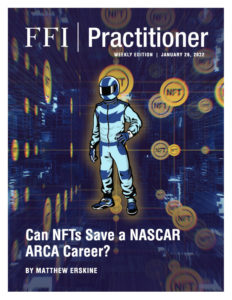
View this edition in our enhanced digital edition format with supporting visual insight and information.
Recently, NFTs have become a popular topic for enterprising families considering whether to invest in the digital collectibles as a way to diversify their assets. In this week’s edition, Matthew Erskine provides an introduction to NFTs and some key considerations relating to their Intellectual Property rights. This article may serve as a helpful conversation starter with your clients who are evaluating whether to begin investing in NFTs.
The recent report that Sotheby’s had over $100 million in Non-Fungible Token (NFT) sales in 20211 is raising questions among creators and collectors about what NFTs are, what role NFTs play (and will play) in the art market, and whether creators and collectors should jump on board the NFT bandwagon.
Those who create and collect art can try to ignore the impact of NFTs, but they can’t ignore how NFTs fit into current Intellectual Property (IP) rights. Others are interested in NFTs not just for investment but as a means of promoting their brand in markets very different from the art market. A recent example of this is Zachary Tinkle,2 a young NASCAR ARCA driver who, after weathering a grave family illness and COVID in 2021, is now exploring using NFTs to fund and promote his 2022 season.
For your family enterprise clients, there are both great risks and opportunities in the NFT market today. To take advantage of the market, it is necessary to understand what NFTs are, what they are not, the role IP plays, and the relationship of IP rights to market brands.
What is an NFT?
A Non-Fungible Token, or NFT, is a digital collectible that is a unique, non-reproducible, digital code representing a digital file. It is analogous to a paid invoice for a painting—it is not the painting. It does not guarantee the authenticity of the painting or convey the ownership of the painting, but it does describe a transaction and points the way towards finding out about the ownership of the real asset it refers to.
NFTs are created when a digital file is uploaded to a third-party NFT platform or distribution network. Since the file is too large to be easily stored on such platforms, an NFT, or hash, is created as a marker to stand in for the digital file. The hash points the way to the URL where the digital file is located. This hash, a digital ID in essence, is unique to each NFT. When an NFT is transacted, the hash is what collectors actually buy and sell. It’s also where the transaction is recorded. This process of identifying the URL of data is called the “smart contract.” The process of creating this digital ID, or NFT, is called minting. In essence, the original owner of the digital file mints a new NFT when uploading a digital file onto an NFT platform.
Once minted, neither the NFT nor the digital file that it points to can be altered, hence why they are referred to as “non-fungible.” If a change is made, the digital ID will reflect that change. When sold, the buyer of an NFT acquires the ability to execute the smart contract that points to the URL of the digital file. The buyer does not, however, acquire any ownership rights to the underlying asset (digital or otherwise) and may not even get the right to display, reproduce, or use the digital file unless those rights are explicitly stated in the smart contract. Additionally, if the NFT is sold at a later date, the buyer may owe a percentage of the transaction price to the creator. The NFT is no guarantee of the authenticity of the digital file or the underlying asset: it only can tell you the provenance of that specific digital file to which it points.
NFTs and Intellectual Property Rights
Intellectual Property (IP) rights are those rights that a creator has over the “creations of their mind.” IP rights are established when the work is created, there is no need to register or trademark the work. These rights include the exclusive right to own, display, use, and reproduce the work. Those rights can be transferred from the creator to others by legal contracts, either before or after the creation of the work. So, someone creating a design for his or her employer is a creator, but if the terms of employment require it, the creator must cede the IP rights to his or her employer.
IP rights, and especially copyrights, are hard to enforce for digital assets. Digital assets are simple to reproduce and easy to display, and it can be difficult to identify the original work. The result is that the creator often rapidly loses control over the rights to a digital file once it enters the digital marketplace.
One notable benefit of an NFT is that the smart contract can be structured so that the creator retains control over the use, display, resale, and reproduction of this specific version of the digital file. Additionally, the creator can add resale rights, so that a percentage of each “downstream” transaction accrues to the creator. For the creator, the NFT goes some way towards mitigating the risks of digital assets in today’s marketplace.
For buyers, there remains the need for due diligence when purchasing NFTs. Just because there is an NFT, there is no guarantee that the “creator” has any rights to either the digital file or the underlying asset. For example, an NFT of a forgery is a valid NFT of fraudulent work. The third-party hosting platforms have procedures to remove fraudulent NFTs, which are usually spelled out, along with the rights of creators, in the Terms of Service. This means that it is important to actually read the Terms of Service before buying an NFT.
The Terms of Service will also describe how the purchase of an NFT affects the IP rights of the creators, as simply the purchase of an NFT does not convey any rights to display, use, or reproduce the digital file unless it is specifically described as doing so. Before purchasing an NFT, make sure your family enterprise clients understand the following:
- What are their rights to use, display, and reproduce the digital file?
- What is the seller’s representation of ownership of rights over the digital file?
- How volatile is the NFT, and what happens if the underlying asset is no longer available?
- What are the dispute resolution procedures?
- What are the terms of any indemnification?
- What do the buyer and the third-party platform disclaim?
Using NFTs for Marketing a Brand
NFTs have not only made money for creators and collectors by the sale and resale rights in these digital markers and digital files, but they have also made money for businesses that use NFTs to market their brands. For some companies, like Campbell’s,3 Taco Bell,4 and others, NFTs are used to promote the roll-out of new products. Other brands have used NFTs that are linked to not only a digital file but also linked to assets in the real world. For instance, offering an exclusive array of products, early access to services, and even the right to vote on some matters such as the names or color schemes of products.
This use of NFTs has little to do with digital assets and everything to do with marketing—creating an emotional link between the product or service and the customer that owns the NFT. Not only can the NFT be scarce enough to have intrinsic value to the collector and the creator, but it gives the creators the opportunity to retell their story over and over again.
For Zachary Tinkle, a professional NASCAR ARCA driver who has thousands of fans already, his NFTs will be less about making money than about promoting his brand for the upcoming season and financing the required $250,000 before the season starts. Selling naming rights for decals on his car may be one way to achieve this. Selling NFTs that give fans the right to enter a lottery for the prime location might be better, as it allows fans to invest in his brand directly.
Conclusion
It is possible, and perhaps likely, that NFTs will fade and become worth little or nothing as a digital asset. It is possible that Zachary’s marketing of his brand for the 2022 racing season will miss its mark. However, it is certain that the NFTs that he, other creators, and even collectors mint, will endure and will be a necessary part of a client’s estate planning. We can look forward to a time when someone strikes it rich by finding the key to a wallet with Zachary’s NFTs among the effects of a deceased relative.
References
1 Akhtar, T. (2021, December 15). “Sotheby’s NFT Sales Reach $100M in 2021.” CoinDesk. https://www.coindesk.com/business/2021/12/15/sothebys-nft-sales-reach-100m-in-2021/
2 Zachary Tinkle 53. (2021). Retrieved January 17, 2022 from https://www.zacharytinkle.com/
3 Campbell’s Commissions First Official NFT Collection by Artist Sophia Chang to Celebrate Changes to its Iconic Soup Can Labels. (2021, July 27). https://www.campbellsoupcompany.com/newsroom/press-releases/campbells-commissions-first-official-nft-collection-by-artist-sophia-chang-to-celebrate-changes-to-its-iconic-soup-can-labels/
4 Albrecht, C. (2021, March 11). Taco Bell Issued NFTs for Digital Taco Art. https://thespoon.tech/taco-bell-issued-nfts-for-digital-taco-art/
–
Disclaimer: The views expressed in this article are those of the author only. The information contained in this article is provided solely for informational purposes. This article does not constitute legal or tax advice or create an attorney-client relationship.
About the Contributor

Matthew Erskine is the managing partner of Erskine & Erskine LLC, a fourth-generation law firm, and The Erskine Company, LLC, a consulting firm. He focuses on strategic planning and legal services for business owners, professionals, individuals, families, collectors, and inheritors of unique assets, helping his clients and their families solve their problems through customized estate, tax, and management solutions. Matthew can be reached at m.erskine@erskineco.com.

View this edition in our enhanced digital edition format with supporting visual insight and information.





